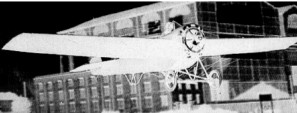Updated: 07-May-2018
Edelweiss presented an unusual engine at the 1913 Paris Air Show.
-The pistons are attached to the outer body, with the cylinders moving.
-The outer body works as crankcase. It is peripheral and surrounds the engine completely.

"Edelweiss"
-As the pistons are attached to that crankcase, the cylinders rise and fall alternately, and to these cylinders are attached the connecting rods, which are linked to the central crankshaft.
-Each cylinder has two connecting rods, one on each side.

"Front view"
-The valves and spark plugs are placed on the outside of the crankcase and protrude to the combustion chambers through the fixed pistons.
-The six cylinders have their own fins. A Zenith carburetor supplied the mixture, and a single magneto provided the ignition.
-It was projected for 60 CV, but It gave 75 CV at 1,350 rpm.

"Rear view"
-In the rear view picture we see the valve control rods, the carburetor and the intake manifold.
-There was a 10-cylinder version giving 125 CV at the same rpm.
From Appendix 7: In a photograph from Schiffer, of Norrep-Lau aircraft, the installation of the Edelweiss engine can be seen - unmistakably.
-Through the main text we know that it is a non-typical rotary radial.
-The cylinders open by the cylinder head rotate inside a ring-collector that closes and uncovers the intake and exhaust ports in its rotation.

"The Edelweiss engine pulling the Norrep"
Engines of EDELWEISS
Model: Radial 6 cils., 75 CV (1913)
Arquitecture: 6-cylinder Radial
Cooling:
Total Displacement:
Bore / Stroke:
Power: 75 CV @ 1350 rpm
Weight:
The pistons are attached to the outer body, with the cylinders moving.

"Newl Edelweiss engine image"


